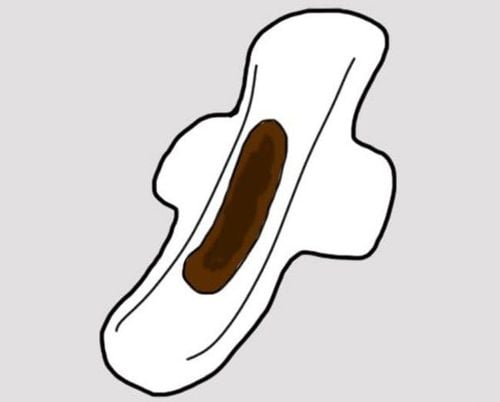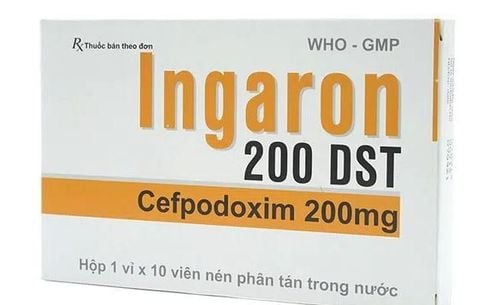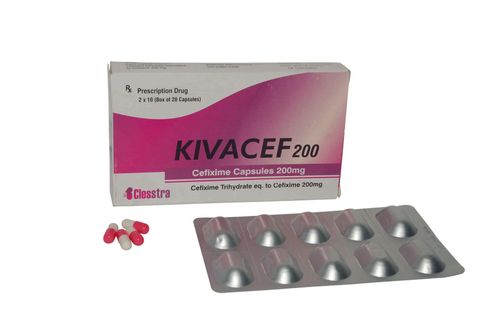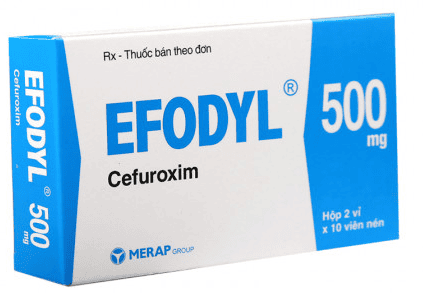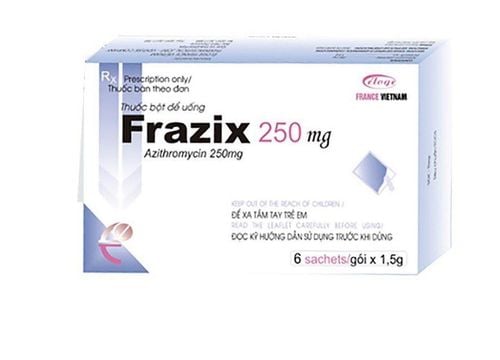This is an automatically translated article.
Kangfixim medicine has the main ingredient Cefixime trihydrate, which is often used in the treatment of infections such as urinary tract infections, bronchitis, pneumonia, dysentery, typhoid,... Let's learn about the uses. Kangfixim drug in the article below.1. What is Kangfixim?
Kangfixim is manufactured by Maxim Pharmaceuticals Pvt. Ltd. - India and circulated on the market with registration number VN-13965-11. Kangfixim is a prescription drug, with the active ingredient being Cefixime trihydrate.
Dosage form: Dispersible tablets, each containing 200mg of Cefixime anhydrous and other excipients of the manufacturer.
Packing form: Box of 2 blisters x 10 tablets and drug instruction sheet.
2. Uses of Kangfixim
Cefixime is a third generation cephalosporin antibiotic, which has good activity against gram-negative bacteria and is stable to betalactamse. Cefixime achieves bactericidal concentrations in the cerebrospinal fluid. For gram-positive bacteria, Cefixime is less effective than penicillin and first-generation cephalosporins. Cefixime is effective against blue pus bacilli (P. aeruginosa).
The effect of the drug has been demonstrated on infections caused by strains of Streptococcus pyogennes, S.pneumoniae, S. agalactiae, Proteus mirabilis, Klebsiella species, Haemophilus influenzae, E.coli, H.Prarainfluenzae, Moraxella catarrhalis , Neisseria menigitidis, N.gonorrhoeae,...
3. Indications and contraindications of the drug Kangfixim
Kangfixim is usually indicated in the following cases:
Urinary tract infections caused by susceptible bacteria. Uncomplicated gonorrhea. Pyelonephritis, a complicated urinary tract infection caused by Enterobacteriaceae. Inflammation of the middle ear. Pharyngitis, tonsillitis. Acute and chronic bronchitis. Community pneumonia. Typhoid. Ly. Contraindications: Absolutely do not use Kangfixim in the following cases:
Hypersensitivity to any ingredient of the drug Kangfixim. Children under 6 months old.
4. Dosage and how to use Kangfixim
Kangfixim is a prescription drug, so patients should only use it when prescribed by a doctor and must follow the instructions for using the drug. Do not arbitrarily change the dose, duration and route of drug administration. Do not share Kangfixim with others or give it to others to use even if they have the same symptoms.
Dosage:
Children > 12 years old and adults: 2 tablets/day (calculated as 200mg tablets). Urinary tract infections due to gonococcal: Single dose 400mg or 200mg / time x 2 times / day. Children from 6 months to 12 years old: 8mg/kg body weight/time/day or 4mg/kg body weight x 2 times/day. Dosage adjustment of Kangfixim is required in patients with renal impairment. Administration: Kangfixim is prepared in the form of dispersible tablets and administered orally.
How to handle when you miss a dose of Kangfixim?
When you miss a dose, take another dose as soon as you remember. Do not take a double dose to make up for a missed dose. How to deal with an overdose of Kangfixim?
An overdose of Kangfixim can cause convulsions. There is no specific antidote to Kangfixim, so treatment is symptomatic. When a patient shows signs of overdose, it is necessary to immediately stop the drug, treat it with gastric lavage, anticonvulsant drugs can be used when necessary. Kangfixim is not removed from the body by hemodialysis, therefore, hemodialysis or peritoneal dialysis is not recommended.
5. Undesirable effects
In addition to the therapeutic effect, the drug Kangfixim may cause some other undesirable effects during use such as:
Common: Dizziness, nausea, headache, insomnia, erythema, urticaria, fever. In the first 1-2 days of taking the drug, digestive disorders often occur,... Uncommon: Pseudomembranous colitis, severe diarrhea caused by Clostridium difficile, anaphylaxis, angioedema, erythema multiforme, Stevens- syndrome- Johnson, thrombocytopenia, eosinophilia, hepatitis and jaundice, elevated liver enzymes, decreased hemoglobin and hematocrit, transient increase in AST and ALT, increased alkaline phosphatase, increased bilirubin, increased LDH, acute renal failure, increased non-nitrogen plasma protein, transient increase in blood creatinine, vaginitis caused by Candida,... Rare: Convulsions, prolonged prothrombin time. These are not all the possible side effects of using Kangfixim, patients may experience other symptoms not listed, reported. Therefore, contact your doctor immediately if you have any unusual symptoms while using Kangfixim.
6. Drug interactions
Drugs that can interact with Kangfixim such as:
Probenecid: Increases peak concentration and AUC of Kangfixim, decreases renal clearance and volume of distribution of Kangfixim. When Kangfixim is co-administered with anticoagulants, prothrombin time may be increased, which may be accompanied by bleeding. Co-administration of Kangfixim with Carbamazepine increases the plasma concentration of Carbamazepine. Co-administration of Kangfixim with Nifedipine increases the bioavailability of Kangfixim.
7. Some notes when using Kangfixim drug
Use of Kangfixim in pregnancy and lactation: there is not enough evidence of safety when using Kangfixim in pregnant and lactating women. Therefore, use this drug only when absolutely necessary and weigh the benefits and risks that it brings. There are no data on the safety and efficacy of the drug in children under 6 months of age. Use caution when driving and operating machinery because Kangfixim causes headaches and dizziness. Kangfixim should be used with caution in people with a history of gastrointestinal disease and colitis, especially with prolonged use because of the potential for development of resistant bacteria.
8. Preservation of drugs
Store Kangfixim in the original manufacturer's packaging, in a cool, clean place to avoid direct exposure to sunlight, at a temperature below 30 degrees Celsius. Keep Kangfixim out of reach of children as well as objects. rearing, avoiding them not knowing how to chew can cause serious unwanted effects. Do not use Kangfixim drugs that have expired or show signs of change in color, properties, taste, or no labels. Do not throw Kangfixim down the toilet or plumbing unless told to do so.




